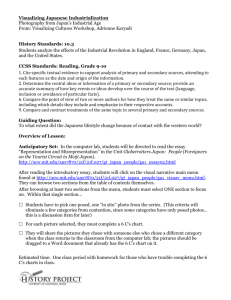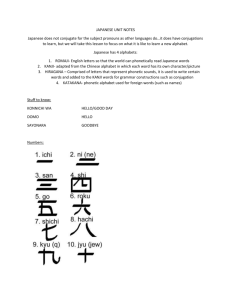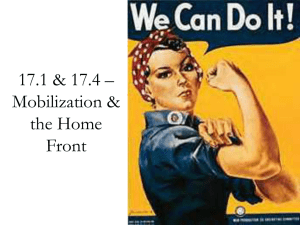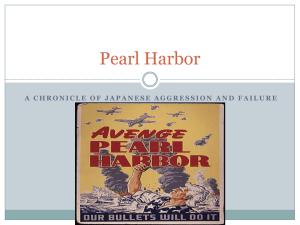10.3 - Opening Up of Japan
advertisement
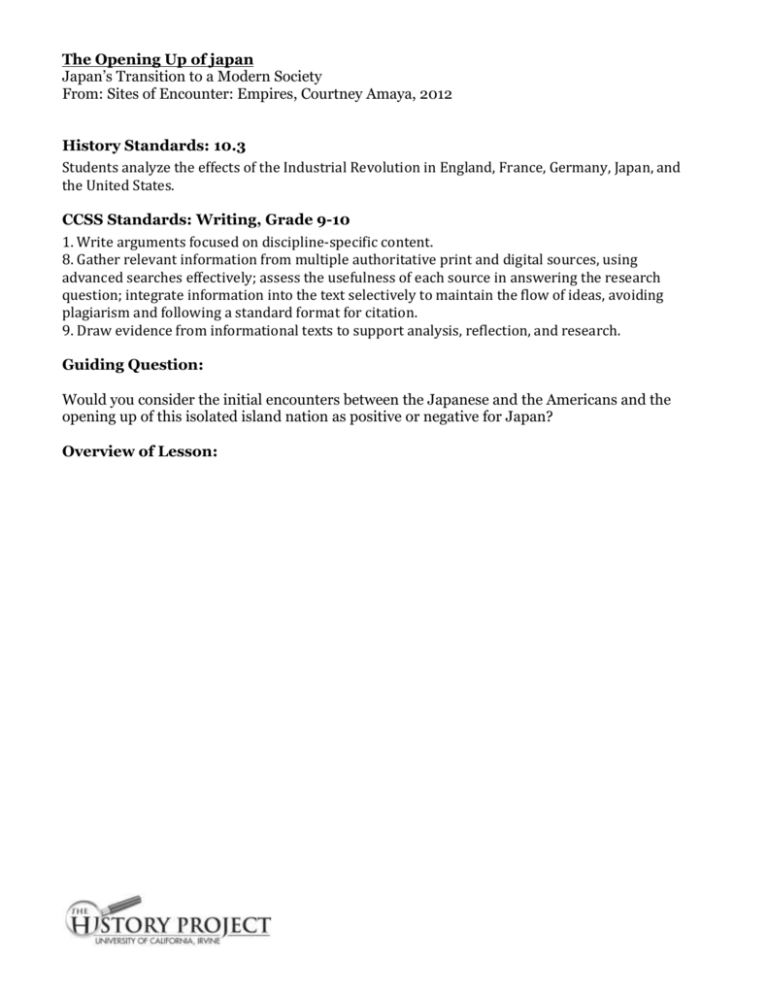
The Opening Up of japan Japan’s Transition to a Modern Society From: Sites of Encounter: Empires, Courtney Amaya, 2012 History Standards: 10.3 Students analyze the effects of the Industrial Revolution in England, France, Germany, Japan, and the United States. CCSS Standards: Writing, Grade 9-10 1. Write arguments focused on discipline-specific content. 8. Gather relevant information from multiple authoritative print and digital sources, using advanced searches effectively; assess the usefulness of each source in answering the research question; integrate information into the text selectively to maintain the flow of ideas, avoiding plagiarism and following a standard format for citation. 9. Draw evidence from informational texts to support analysis, reflection, and research. Guiding Question: Would you consider the initial encounters between the Japanese and the Americans and the opening up of this isolated island nation as positive or negative for Japan? Overview of Lesson: Visualizing Cultures Website – The Opening Up of Japan Purpose: The Visualizing Cultures website is an excellent visual tool to use with your class, as well as a rich source for teachers to access in-depth information on China and Japan. The following assignment is an example of how I introduce the opening up of Japan to the West and its transition from a feudal to modern society. I will first utilize the Visualizing Cultures Website and then move on to a lesson from the HOT Curriculum. Materials: 1. Computer 2. LCD Projector 3. Internet Access 4. Student Handout Encounters Facing East - Step 1: Go to: http://ocw.mit.edu/ans7870/21f/21f.027/black_ships_and_samurai/bss_visnav01.html The “Facing East” page documents Commodore Matthew Perry’s encounters with Japan. The visuals were taken by William Heine. 1. Scroll to the right. Read aloud the narrative to your students as you show them the visuals. It is helpful for students to expand upon the narrative information about Perry’s encounter with Japanese officials (either using your textbook and/or the ESSAY by John Dower - located on this site). http://ocw.mit.edu/ans7870/21f/21f.027/black_ships_and_samurai/bss_essay01.h tml (essay link) 2. Ask students to answer the following questions while viewing the page: In the first few visuals Heine documents many of the places visited while en route to Japan. What words would you use to describe his paintings of Ceylon, Mauritius, etc…? What do these paintings all have in common; is there a particular focus? What words would you use to describe the paintings of Japan? What do the paintings of Japan all have in common; is there a particular focus for most of them? Describe the clothing differences between the Japanese and Americans. Do you think Heine viewed the Japanese in a positive or negative way? Explain. Encounters Facing West – Step 2 The “Facing West” page documents the Japanese perspective of Commodore Matthew Perry’s arrival in Japan. 1. Scroll to the right. Read aloud the narrative to your students as you show them the visuals. 2. Ask students to answer the following questions while viewing the page: In what ways are the Japanese paintings different from William Heine’s paintings? What words would you use to describe the Japanese artwork? What is the focus of most of the paintings? Do you think the Japanese viewed the Americans in a positive or negative way? Explain. Black Ships – Step 3: 1. Show students the picture of the USS Powhatan (which sailed on Perry’s second Japan mission) a. Explain to students that the Powhatan was Perry’s flagship and showed off the newly mechanized American navy. The Powhatan is a steamship (you can point out the waterwheel in the middle of the vessel). i. Perry’s fleet included both sail and steam-driven ships. In response to the wind, the steamers conserved fuel by hoisting sails. At times, they towed the sail ships to speed the journey along. 2. Now go back to the website and click on Black Ships Facing West: (http://ocw.mit.edu/ans7870/21f/21f.027/black_ships_and_samurai/bss_visnav04.html) 3. Read the introduction and show them the first image ONLY (see below). 4. Students should write down their initial impressions of this image. 5. Now scroll to the right. Read aloud the narrative to your students as you show them the visuals. a. I only go through the images that breakdown the image above. Step 4 - Writing Assessment: 1. Now that students have seen and heard about the American encounter with the Japanese in 1853-54, it is important that they synthesize the information they’ve learned. Students will write a paragraph (5 sentences minimum, including a thesis) answering this prompt: Would you consider the initial encounters between the Japanese and the Americans and the opening up of this isolated island nation as positive or negative for Japan? Step 6 - Video 1. Show the video clip – “History vs. Hollywood” from The Last Samurai The Opening Up of Japan Website: http://ocw.mit.edu/ans7870/21f/21f.027/black_ships_and_samurai/bss_visnav01.html Directions: Answer the following questions as you work your way through the Visualizing Cultures website. Facing East Questions: 3. In the first few visuals Heine documents many of the places visited while en route to Japan. What words would you use to describe his paintings of Ceylon, Mauritius, etc…? 4. What do these paintings all have in common; is there a particular focus? 5. What words would you use to describe the paintings of Japan? 6. What do the paintings of Japan all have in common; is there a particular focus for most of them? 7. Describe the clothing differences between the Japanese and Americans. 8. Do you think Heine (the artist) viewed the Japanese in a positive or negative way? Explain. Facing West Questions: 9. In what ways are the Japanese paintings different from William Heine’s paintings? 10. What words would you use to describe the Japanese artwork? 11. What is the focus of most of the paintings? 12. Do you think the Japanese viewed the Americans in a positive or negative way? Explain. Part 2: “Black Ships” – The Japanese perspective of the American fleet. 13. List the first thoughts that came to your mind when you viewed this image: 14. Would you consider this painting of an American ship positive or negative? Explain. 15. “The warship was pitch black and the figure-head on the prow was a leering monster”. Why do you think the artist portrayed parts of the ship as a monster? Final Assessment - Writing for Understanding: Now that you’ve seen visuals and listened to the historical context surrounding the encounter between America and Japan that began in 1853, you will write a paragraph (minimum of 5 sentences, including a thesis) answering the following prompt: Would you consider the initial encounters between the Japanese and the Americans and the opening up of this isolated island nation as positive or negative for Japan?
